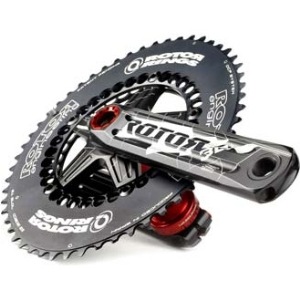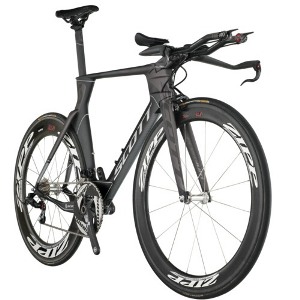Praxis Works Chainrings
Raise your hand if you like it when your bike shifts smoothly between its small and big chainrings. Keep your hand up if you agree that dropping a chain mid-race slows you down. Now… keep your hand up if you regularly contemplate the intricacies of your chainrings’ grain structure, manufacturing methods, and shift ramp timing.
Where did all the hands go?
See what just happened? I had you paying attention for a minute… then the talk got technical, and you started thinking about lunch or got distracted by a shiny object. I’m here to tell you that the following article really isn’t that technical, and you may just learn something that makes you faster on race day (or helps avoid things that slow you down – like overshifting your chain clear off the ring).

I’m an odd bicycle geek. The most aero frame doesn’t do it for me. The lightest wheels aren’t really what revs my engine. Some may think that I’m a grumpy old mechanic and want simplicity and durability at any cost (including heavy weight). Nay! What I value is: function. I want the smooth, efficient, and precise function of a well-designed machine. An effect of this tends to be a design of general simplicity – and it also often assumes that the product in question is not the absolute lightest on the market (but it by no means assume it’s the heaviest, either). I want stuff that works. I’m generally willing to pay the price for it too, but it’s always a bonus when my champagne taste happens to fit into a beer budget. Perhaps not a PBR budget, but priced low enough that I don’t feel guilty.
I’m happy to report that I’ve found a product that perfectly fits this bill. I found something that could actually make you faster, and the benefit could easily outweigh the fastest set of wheels. I found Praxis Works chainrings.
Praxis-who? While you may not have heard of them yet, I have a feeling we’ve not seen the last of this company. Praxis Works is a unique beast in the cycling industry – it is a brand that actually manufactures something. Or rather, Praxis Works is a brand owned by a very large factory in Asia, which specializes specifically in the forging of metal. The “real” company is the factory; they just happen to operate their own retail-selling brand. The bulk of this factory’s business has nothing to do with cycling at all. The car you drive or the laptop you’re using to read this article could very well contain forged metal parts made by Praxis Works’ parent factory.
I spoke with Adam Haverstock, who is their highly knowledgeably and smooth-talking man of all-things-PR. Since they speak so well of their forged rings, I had quite a few questions for him.
First and foremost, why does it matter how your chainrings are made? Why does it matter how any metal part is made? I soon found out that it matters indeed. For most components on your bike, there are a few common processes by which metal parts are manufactured. First is machining. For something like a chainring, this starts with a blank disc of aluminum or steel. A computer numerical control, or CNC, machine cuts out the part into the desired shape using drill and mill bits. This leaves you with a relatively finished part that can later be anodized, laser-etched, painted, etc. The whole machining process essentially starts with a big chunk of metal, and cuts it down in to something smaller.
An expensive and much-less-common alternative to CNC machining is forging. Forging is the brute-force bigger brother to machining. It works by – quite literally – smashing metal in to shape… almost as if it were a piece of clay. Even at room temperature, aluminum is a malleable substance; you just have to use a lot of force to make it squish. How much force? Adam at Praxis tells me that their chainring forging process requires a machine that is two stories tall and uses 1,000 tons of force. Sound a little excessive? It’s like saying, “Rather than use this measly hammer to drive that nail in to the wall… why don’t I just drive my car into the nail at full speed?” Whatever floats your boat.
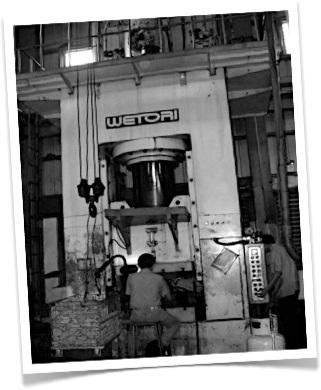
At first glance, these two chainrings look very similar. On top you have the Praxis ring, and below, a SRAM Red (2011).
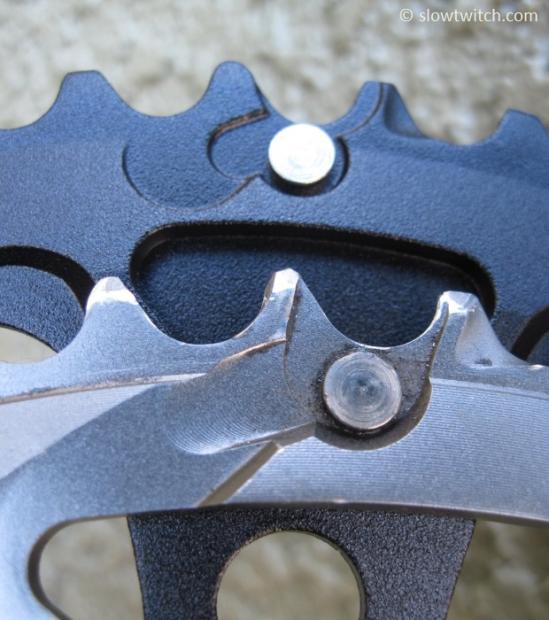
But a slight adjustment of focus reveals the machined nature of the SRAM ring. Those ridges are tell-tale marks from a mill bit making a quick pass to remove material from the back of the chainring.
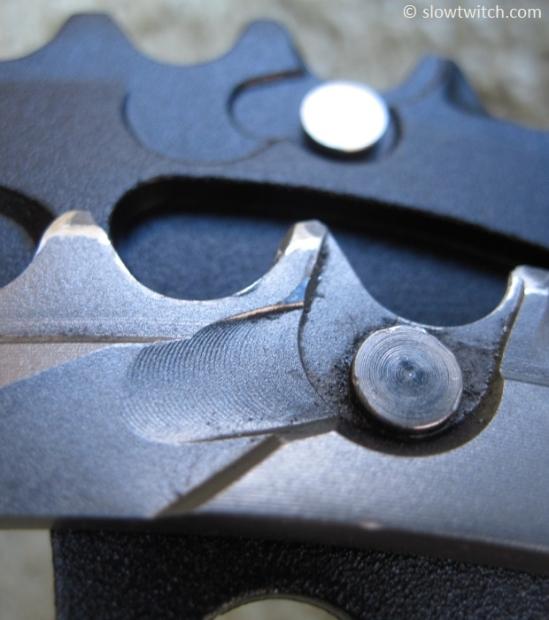
As of today, there are only two companies who forge bicycle chainrings. First is a large Japanese company that also makes fishing reels… and the other is Praxis. Nobody else is doing it. This is largely due to the fact that it’s so expensive. But why bother with it?
The beauty of forging is several-fold. You may not know it, but cast metal is similar to wood in that it has a grain structure. Trees grow with the fiber in a certain direction for strength. With cast metal, this grain direction is essentially random. When you forge that metal, however, you have the ability to force the grain structure in the direction you want it. This affects the physical toughness and hardness of the product. For us bicycle geeks, this means you can also affect the stiffness of a chainring based on the anticipated load or force, and direction of that load. If you thought it was only carbon fiber that could be “tuned” for stiffness in a given plane, think again.
The idea of forging made sense to me during our conversation. I thought back to my many different bikes over the years… indeed, my best shifting was always on forged Shimano chainrings. I had more questions for Adam, however. Isn’t forging only half the battle? What about the shape and placement of shift ramps and pins? These are the little features you see on the back side of your big chainring, which assist your chain in making the climb from small to big ring. Designing these well is both art and science.
The science half is due to the fact that there already many patents on chainring technology. You’ve got to avoid the outlawed designs and find a way around it that works. The art half is analogous to the wind tunnel. You may have an idea of how you think something will perform during the initial design process… but you never really know until you test it. With bike frames, this means many trips to the wind tunnel. With chainrings, it means installing, testing, and making revisions over and over again. The action of the shift must be designed in a certain way. Perhaps very tall chainring teeth provide better chain retention in a situation of extreme cross-chaining. But that may also mean the chain has a tougher time making the climb from small to big ring. There are countless other considerations (and compromises) that must be made in order to achieve a shift that is as close to perfect as possible. Praxis’ take on this math problem is a technology called LevaTime. While I’m no chainring engineer, it sounds like they did their homework. And – as I always say – the proof is in the pudding. If it really worked, I’d find out soon.
I lined the SRAM ring (below) and Praxis ring (above) at the same timing point, to compare the differences. As we see here, some portions of the rings look nearly identical.
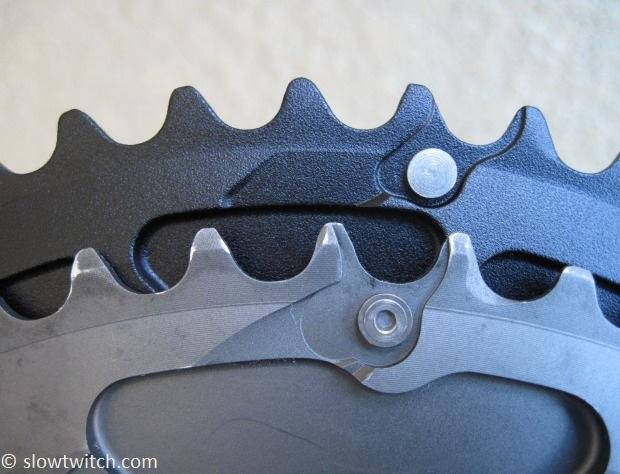
I observed that both the SRAM and Praxis rings had a similar number of large shift ramps with pins, as photographed above. The pins’ job is to catch an outer chain link to assist in climbing up to the big ring.
The big difference I noticed, however, was the number of smaller intermediate ramps:
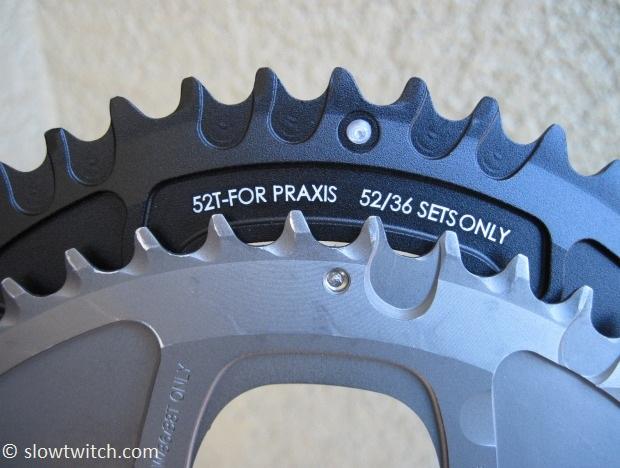
My guess is that these ramps are intended to aid in achieving a shift in the case that the chain does not catch a shift pin.
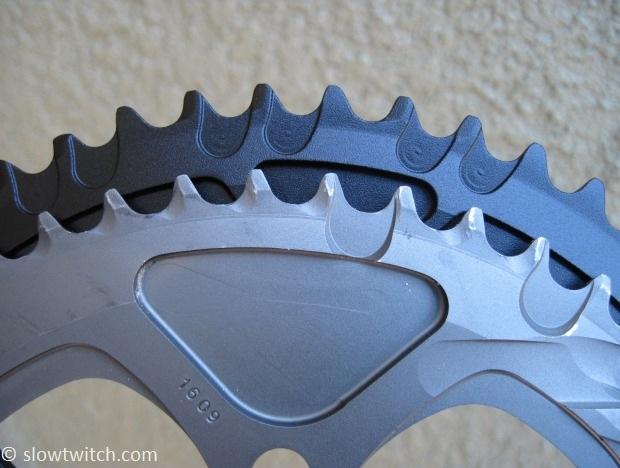
Time to Test
I had two test cases to work with. First was a Cervelo P2C with a SRAM Force 53/39 crankset, Rival front derailleur, and 1091 chain. Second was a Trek Speed Concept with SRAM Force 52/36 “mid compact” crankset, Force front derailleur, and 1091 chain. I intended to swap out the rings for equivalent-size Praxis rings.
The 53/39 set is a standard 130 bolt circle diameter. To me, they just looked like chainrings… nothing special to see here.
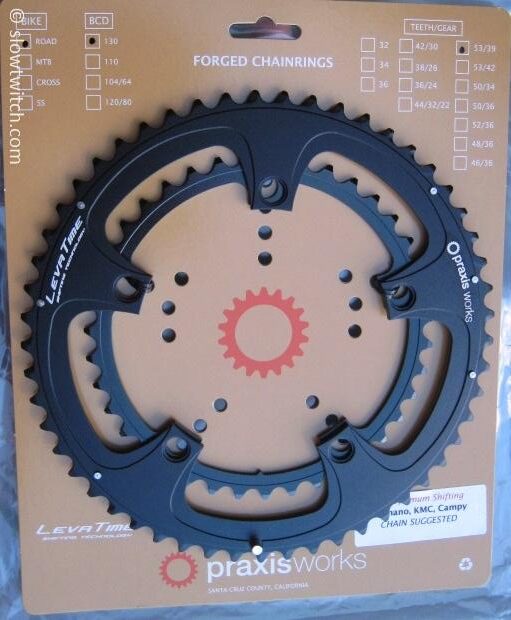
The bike started out looking like this:
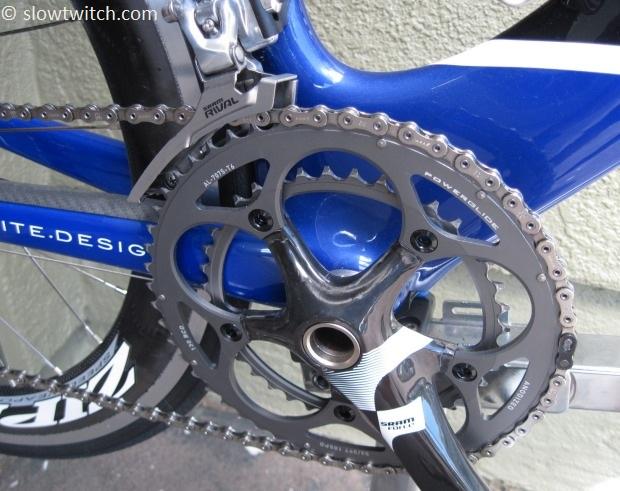
I installed the chainrings, retaining the stock bolts. Keep in mind that chainrings are timed to work in a certain orientation. The pickup pin must be behind the crankarm, and Praxis provides this small “nub” to help you line up the small ring properly.
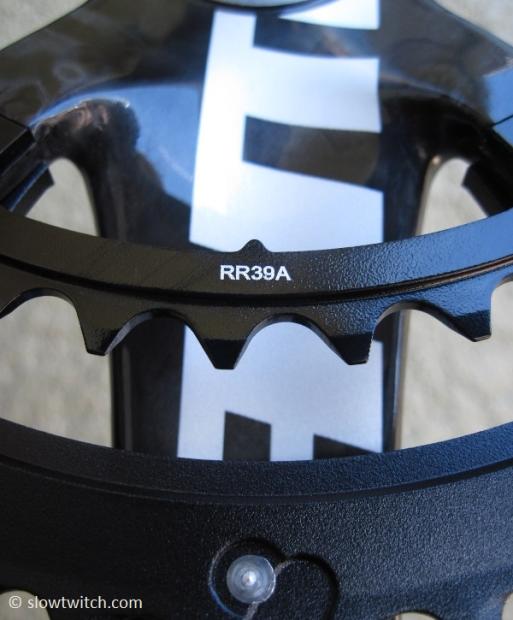
Praxis wholeheartedly recommended that I treat this like the “Pepsi Challenge”… see how it works for yourself. I installed the rings and was ready to roll.

For now, I decided to try the rings with the stock SRAM Rival derailleur and 1091 chain. Praxis was clear in communicating that their top recommended chains were Shimano, KMC, and Campagnolo… but that I was welcome to try any chain I wanted. When asked about this, they simply stated that the rings are not specifically designed for any one chain out there, but that they just see better real-world shift performance with the three recommended chain brands.
With the rings finally on the bike, I got to shifting. And shifting… and shifting some more. How did they work? To be perfectly honest, my initial impression was something to the tune of, “yes, they’re better, but not remarkably so.” I didn’t have any dropped chains off of the outside or inside, which was a positive step. With the bike in the trainer, general ring stiffness seemed to have improved when you really stomped on the pedals.
Being a very finicky mechanic, I double and triple checked all of the derailleur adjustments. Limits? Check. Front derailleur height? Check. Cable tension? Yep. Cage parallel with the rings? You bet. I even got a little crazy with the setup just to be sure I wasn’t missing anything. The stock setup seemed to be best – about 1.5mm clearance between the teeth and cage… and the outer cage exactly parallel to the big ring.
I decided to take step two of the challenge: Shimano Ultegra 6700 chain and front derailleur. While the derailleur wasn’t “required” by Praxis, they did mention that their front derailleurs tended to do better overall.
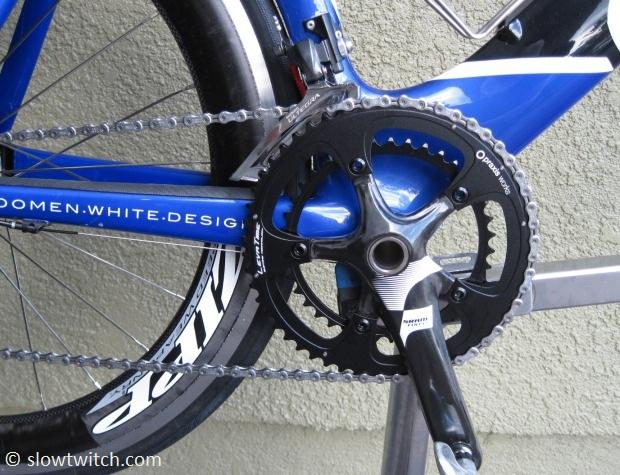
How did it work now? One word; three letters; first one capitalized for emphasis… Wow. The system worked really well.
Over time, I’ve come to define four types of front shifting:
1. A clean, successful shift.
2. The clunky, forced shift. The chain makes its way to the big ring; just not quietly or happily.
3. “Overshift”. This is where the chain thinks it wants to climb up and over the big ring. It rides up on the teeth for about half a pedal revolution, before slapping down in to place.
4. Dropped chain. The chain goes up, over, and off the outside.
On the stock setup, I experienced all four types of shifting. With the full recommended Praxis setup, I completely eliminated number two and four. I had clean shifts about 80-90% of the time, with the occasional slight overshift. While not perfect, it was quite an improvement.
This test bike in question actually happens to belong to my significant other, who would not advertise herself as the most tech-savvy triathlete in the world. She is like the majority of recreational age group triathletes out there – she just wants a bike that goes forward when you pedal. In actuality, that makes her the perfect test subject. Well-designed components shouldn’t require any skill to operate. I don’t want to have to shift at a certain pedal speed, or press the lever at a “perfect” pressure. I don’t want to have to soft-pedal at thirty watts, and I most certainly don’t want to drop chains.
My instructions were simply: “Go ride. Don’t baby it. Let me know if you ever drop the chain.” Since then, the bike has been ridden for several weeks in the most demanding condition for front shifting – the indoor trainer. With the high chain tension and relative inability to coast or soft pedal, this is a true test of front shift performance. After this test period, I’m pleased to report zero dropped chains and a happy rider.
Test subject number two was a Trek Speed Concept, with a SRAM 110 BCD Force crankset and 52/36 rings, along with their braze-on Force front derailleur and 1091 chain.
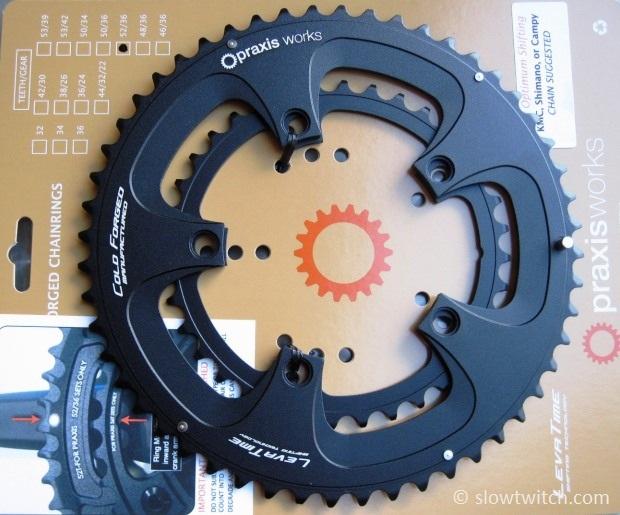
This time around, I opted to swap straight to the Praxis 52/36 rings and Shimano front derailleur; but threw in a wild-card Wippermann Connex 10SX chain. Way back when in my bike shop days, Wippermann chains always had a reputation for quality. Specifically, they were known for lasting a long time, and never breaking. However, they seemed to lack lateral flexibility, and didn’t operate as quietly or shift quite as smooth as competition from Shimano and KMC. In any case, I wanted to give it a fair shake with these high-end rings.
Unfortunately, the reputation held true. While likely an ideal choice for, say, 24 hour mountain bike racing (where reliability is paramount), the chain suffered from conditions two, three, and four listed above. For those unaware of what “overshifting” looks like, here is a photograph. As soon as the chain started to climb, I stopped pedaling, to freeze the action.
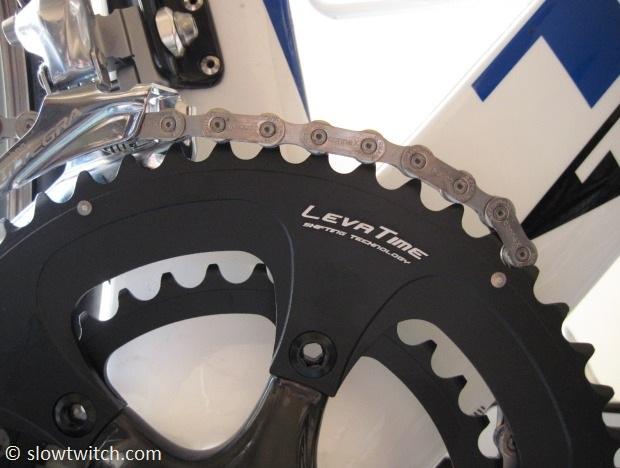
As I continued to turn the crank, you can see that the chain eventually settled down in to place on the teeth (below).
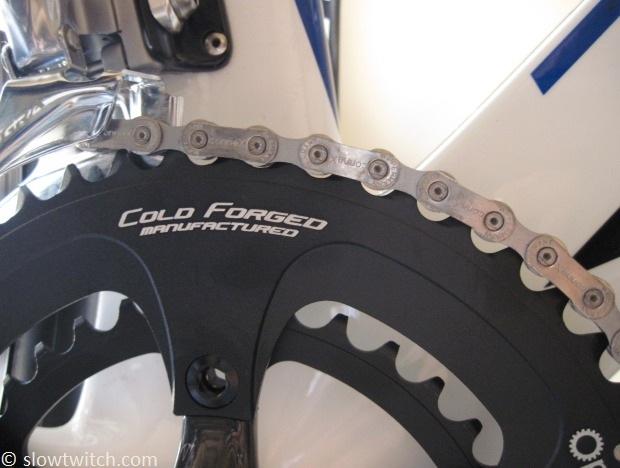
I opted to swap out the chain for a new Shimano 6700. As expected, shifting improved. In the end, it was not quite up to the level of the 53/39 set, but I attribute that to the larger gap in teeth (52 minus 36 equals 16 teeth… 53 minus 39 equals 14 teeth). The bigger the difference in chainring size, the more difficult it is to achieve a perfect shift – and this goes for any manufacturer. Still, the Praxis Works rings combined with Shimano chain and front derailleur resulted in a great shifting setup. I’d venture a guess that this is the best-shifting 52/36 on the market. It’s a relatively new size option, and this is the only one that is forged.
Are they for you?
So who exactly is the right customer for this product? I was very upfront with the folks at Praxis Works on my opinion of these rings. While they are certainly an upgrade from stock, they were not what I considered to be “Di2 perfect”. For anyone who has ridden a properly setup Di2 bike, you know what I mean. Shimano has a chainring that is both hollow and forged. It’s super stiff, and they hold some key patents on shift ramp technology. Combine that with the fact that electronic shifting holds a single advantage that no mechanical system can match – shifting speed. Mechanical systems rely on the user to move the front derailleur; some may do it fast, some slow. How quickly and forcefully you do it affects the shift. Di2 takes that out of the equation entirely.
Adam asked me to rate various chainrings on a scale of one to ten. I responded that I’d call Di2 a ten, followed by Dura Ace mechanical, Ultegra Di2, Ultegra mechanical, and then on to others from various manufacturers. A cheap OEM ring could be called a five. Adam expressed that they understand that they are not quite at the level of Dura Ace, but also pointed out that their price is substantially cheaper. At an MSRP of $170 per set, the Praxis rings cost about half of Dura Ace 7900. As a comparison, a set of FSA road rings tends to run around $125. Praxis is really targeting that customer who has a standard 5-bolt crank and is looking to upgrade without spending an arm and a leg. I’d say that they offer an exceptional value for what you get, and easily hit a “9 out of 10” on the performance scale.
What are your size options? As of this writing, Praxis offers road rings in 53/39 for standard 130 BCD cranks, and 52/36, 50/36, and 50/34 for compact 110 BCD cranks. All are said to be compatible with 9, 10, and 11-speed chains (although they do not offer anything in Campagnolo’s proprietary 135mm BCD – so you’d have to run a non-Campy crank to use these rings). They also offer a host of cyclocross and mountain bike sizes, but, they unfortunately do not currently offer anything in the big kid range of 54-56 teeth. Keep in mind that Praxis rings do not work with the new 2012 SRAM Red crank – the design of this crank rotates the rings 180 degrees from the normal position, which would leave the pickup pin exposed if you attempted to mount a Praxis chainring.
Another very cool product that Praxis just debuted is their Dura Ace 7950 “Integrated Set”. Shimano was very smart in designing a crank with proprietary rings. Specifically, the outer chainring is female-threaded specifically for their bolts. You just can’t put a standard 5-bolt chainring on there. The problem solvers at Praxis came up with a unique set of female-threaded caps, which allow the use of any standard ring on the Dura Ace 7950 compact crank. This is a boon for cyclocross racers, or anyone wanting to run the now-popular 52/36 mid-compact… Shimano doesn’t make any rings in those sizes.
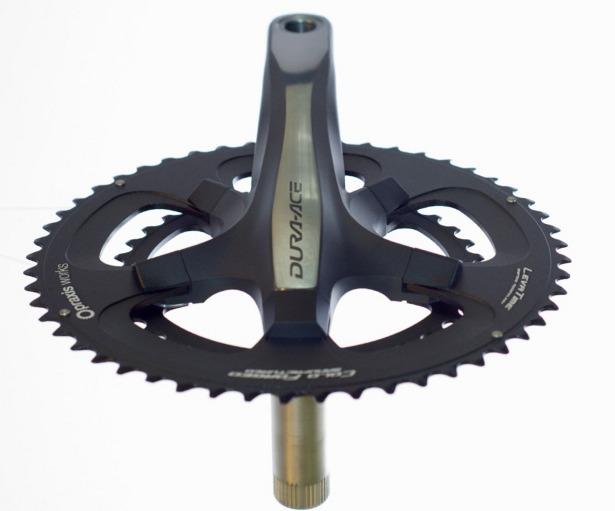
What if you already own a crank-based power meter, such as SRM or Quarq? SRM readily approves the use of Praxis rings, as long as you have the meter calibrated for their use (which is standard procedure for any chainring). Different cranks and rings flex and behave differently, so the SRM must be calibrated to take this into account. For some reason, Quarq does not approve the use of Praxis chainrings. They stated that the Praxis rings are “out of our spec”, and change your power reading. It seems curious to me, however, because they can calibrate properly for both a standard Red ring and a Red solid TT ring, which are of a different weight and stiffness. The slope can be set similar to an SRM, so I don’t quite understand the issue – just be aware of this consideration if you wanted to put Praxis chainrings on your Quarq crank.
Wrap Up
See? That wasn’t so bad, was it? Chainrings are admittedly a very tough sell. They’re not sexy, and most people simply don’t think about them. Well – that is, unless their chain drops while trying to shift.
With that in mind, I’m a big fan of focusing your bike upgrade dollars on these things that just have to work all the time. Nobody wants to worry about their bottom bracket bearings failing, or their seatpost slipping, and especially not whether their chain will stay put on the ring. The fastest frame, helmet, tires, or wheels will do nothing for you if something mechanical fails and you’re left on the side of the road waiting for assistance. If you already have a full Dura Ace or Ultegra bike – and are happy with your existing chainring sizes – you probably won’t gain much by switching to Praxis rings. If, however, you have almost any other crank and chainring on the market, this is a worthy upgrade that can make a real difference. If your rings are worn out and you’re ready for a replacement set, it’s a perfect opportunity to make the change.



